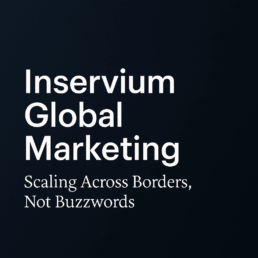AASCO - Marketing Company Based in Moldova
AASCO - Ahead Advertising Solutions Company
Creative Intelligence That Moves Business Forward
Some agencies design logos.
Some run ads.
Some sell templates.
We don’t do any of that.
At AASCO, we build decision-making systems for modern brands.
Not services — strategic intelligence, expressed through design, marketing, and clarity.
We’re not an agency.
We’re the creative core of a growth infrastructure.
What AASCO Actually Is
AASCO is the flagship creative and marketing company in the GDSN ecosystem.
But our role goes far beyond branding.
We:
-
Design brand identities that align with business direction
-
Architect campaigns that drive qualified demand
-
Build marketing funnels with performance logic
-
Craft narratives that anchor your brand in the minds of clients
-
Integrate design, psychology, and revenue strategy into one system
Everything we do is rooted in one principle:
If it doesn’t move the business forward, we don’t build it.
Why We Created AASCO
Because most marketing today is disconnected and improvised.
Founders jump between:
-
A freelancer for the website
-
A designer for the logo
-
A media buyer for ads
-
A consultant for strategy
But no one sees the whole picture.
We built AASCO to solve that.
One company, one logic, one voice — from idea to execution.
We operate like a creative operating system for businesses who don’t want to guess anymore.
The AASCO Approach
Every AASCO project follows a principle:
Psychology first, design second.
We begin with:
-
Audience and industry research
-
Competitive positioning and emotional mapping
-
Business model review
-
Visual system planning
-
Funnel and campaign architecture
Only then do we design.
Only then do we launch.
We treat marketing like engineering:
Structure → Blueprint → Build → Iterate → Scale.
No fluff. No guesswork. No templates.
Our Core Disciplines
1. Strategic Branding
We define brand cores, value statements, visual identities and verbal architecture — always tied to business outcomes.
2. Performance Marketing
Google Ads. Meta Ads. Local SEO. Landing pages that convert. Campaigns that feed sales — not likes.
3. Creative Design
Websites, identities, pitch decks, packaging. Everything clean, coherent, and conversion-driven.
4. Campaign Systems
We build multi-touchpoint systems with automation, CRM integrations and full-funnel visibility.
5. Partner Ecosystem
As part of GDSN, AASCO collaborates natively with M Digital Network and Inservium for technical and international execution.
Who AASCO Is For
AASCO works with:
-
Founders tired of scattered marketing
-
Service businesses that want clarity and results
-
Product companies seeking deep market resonance
-
Municipalities and public organizations that need professional positioning
-
Agencies looking to scale with a strategic partner
If you want gimmicks, we’re not for you.
If you want structured growth with elegance, intelligence, and logic — let’s talk.
Our Design Language
Inspired by:
-
Apple’s clarity
-
Notion’s calm
-
TBWA’s precision
-
Strategic psychology
Our work looks clean — but it’s deep.
No clutter. No noise.
Just decisions made visible.
AASCO Within GDSN
We are the creative engine of the GDSN structure:
-
Inservium handles global marketing logic
-
M Digital Network builds the systems and CRM tech
-
MCHS runs the infrastructure and hosting
-
AASCO builds the interface between you and the world
We make sure that what you say, what you show, and what you offer —
all speak the same truth.
Final Words
You don’t need another campaign.
You need a system that understands your business and expresses it precisely.
That’s what we build at AASCO.
Because in today’s market, the difference between growth and stagnation
is how clearly your message lands.
Inservium Global Marketing
Scaling Across Borders, Not Buzzwords
In a world obsessed with “global expansion,” most marketing agencies are still trapped in local thinking dressed up in international packaging.
They speak in buzzwords.
They sell vanity metrics.
They tell you to “go global” — but they can’t even handle multilingual strategy or ad distribution outside their own timezone.
That’s why Inservium exists.
Not to impress.
To scale — intelligently, strategically, and sustainably.
What Is Inservium?
Inservium Global Marketing Company is our international marketing division.
But it is not a “global agency” in the traditional sense.
It’s a cross-border acceleration system built for:
-
B2B companies with technical or service-based offerings
-
Local businesses looking to expand regionally
-
Public institutions with multi-language audiences
-
Digital entrepreneurs with scalable products
-
Educational and consultancy platforms with international scope
Inservium is designed for clarity, not clutter.
It replaces generic outreach with researched, multilingual, conversion-oriented execution.
What We Saw Before We Built It
We worked with too many businesses that had:
-
A great product that sold in one country and failed silently in the next
-
“International” campaigns run by agencies that couldn’t localize tone or logic
-
Landing pages translated with Google, but lacking cultural context
-
Budgets spent on reach with no qualified leads in return
It became clear:
Going global isn’t about wider reach.
It’s about deeper relevance in multiple contexts.
That’s what Inservium was built to solve.
What We Actually Do
We don’t run ads and hope.
We build layered marketing systems designed for cross-border traction.
We operate in English, Romanian, French, and Russian — not just as languages, but as cultural layers.
We plan, execute and optimize campaigns across Europe and beyond with localized infrastructure and narrative adaptation.
Here’s how:
-
Strategy and content development by region and audience type
-
Advertising campaigns across Google, Meta, LinkedIn, YouTube and more
-
Dedicated landing pages, funnels and automation flows per geography
-
CRM integration, lead capture, and follow-up customized by market
-
Performance tracking based on qualified outcomes, not just impressions
Every country has its own emotional logic.
Every city has a timing pattern.
Every audience has a decision trigger.
We map them all — then we deploy.
Who It’s For
Inservium works with founders, marketing teams and institutions that:
-
Need structure, not slogans
-
Operate in multiple countries and want a single, consistent system
-
Sell services or high-trust products that can’t rely on mass ads
-
Value message clarity over flashy visuals
-
Want results across borders without losing their core identity
We don’t offer shortcuts.
We offer scalability — real, structured, and managed.
We Don’t Sell Exposure
Exposure without logic is expensive noise.
Most “global” agencies sell traffic, not traction.
We build systems that give you:
-
Presence that translates into real inquiries
-
Visibility that’s backed by trust
-
Marketing messages that land, not just display
-
Strategic clarity that can be repeated, scaled, and improved
You don’t need more followers.
You need architecture.
Part of the GDSN Ecosystem
Inservium doesn’t work alone.
It operates as part of the Global Digital Solutions Network (GDSN) — a full-stack ecosystem designed for autonomy and structured growth.
-
AASCO provides the creative and strategic positioning
-
M Digital Network builds the CRM, automation and backend logic
-
MCHS powers the infrastructure with private hosting across regions
-
GDSN connects it all legally, financially and structurally
This is why our cross-border work isn’t just translated — it’s engineered.
Final Words
Crossing borders with your brand is no longer about translation and hope.
It’s about building a logic that travels.
That’s what Inservium is here to do.
For companies that don’t want to just appear in new markets —
but build presence, consistency, and impact within them.
Why We Build What We Build
The Human Code Behind AASCO, M Digital Network, and the Global Engine We Call GDSN
At first glance, we’re just a marketing agency. Or a digital network. Or maybe a cloud infrastructure company.
But if you look closer, you’ll see a pattern.
A logic. A design.
A living system made not of code and servers — but of conviction.
We build systems that other companies build on.
We design strategies that ignite business direction.
And we don’t do it randomly.
We do it because the world is too full of noise, promises, and sterile “solutions” that don’t connect.
❍ So, What Exactly Do We Do?
We operate multiple brands — each focused, specialized, but interconnected like organs in a single body:
-
AASCO Marketing – Branding, campaigns, design, and positioning for companies that need more than just visibility — they need meaning.
-
M Digital Network – A backbone for modular software, cloud services, infrastructure and systems that businesses run on.
-
Iservium Global Marketing – Strategic reach across borders. Built for scaling impact across geographies.
-
GDSN (Global Digital Solutions Network) – The holding ecosystem that legally and structurally supports every initiative we launch.
And together, these are not just business lines.
They are interfaces between vision and execution.
We Don’t “Offer Services.”
We Build Control Systems for Founders Who Want Autonomy.
Most founders don’t want more tools. They want more clarity.
They don’t need another CRM — they need a system that adapts to how they think.
That’s where we come in.
We build marketing, branding, CRM, ERP, cloud, hosting and digital infrastructure in one logical architecture.
So your startup doesn’t depend on 17 tools and 6 freelancers — just one ecosystem, made for growth.
We don’t pitch you apps.
We engineer business independence.
Why We Started: Because We Were Tired of Improvising
We’ve been through the sleepless nights, the unstable cash flow, the broken client funnels.
We’ve worked with clients who were juggling:
-
A slow Wix site
-
An underperforming Facebook page
-
A CRM that didn’t speak to the sales team
-
Ads that burned budgets but not leads
So we said: What if we design an ecosystem where everything speaks the same language?
Where:
-
Marketing isn’t just design — it’s a growth command center
-
Infrastructure isn’t rented — it’s owned and optimized
-
Clients don’t just get “work” — they get partnership logic
We called that vision GDSN.
We gave it operational arms: AASCO. M Digital Network. Iservium.
And we went to work.
We Are Not a Product of AI
But We Work With It — On Our Terms.
Let’s be real: most blog posts these days sound like they were written by ChatGPT.
This one wasn’t.
This is a founder speaking.
A builder. A strategist. A fighter.
We use AI like we use code, servers or psychology:
To create leverage, not illusions.
We’re not here to fake depth.
We’re here to build it.
What Makes Us Different?
🛠 We build systems, not services
Everything is modular, upgradable, and connected — from your lead gen to your invoices.
⚙️ We offer full-cycle control
Design → infrastructure → marketing → automation. Done in-house, no outsourcing chaos.
🧠 We think like entrepreneurs
We don’t pitch ideas. We map opportunities, calibrate strategy, and execute with discipline.
🌍 We’re structured for scale
Whether you’re in Romania, France, Moldova, the U.S. — our systems are built to cross borders and multiply impact.
For the Client Reading This:
You don’t care how fancy our logos are.
You want results. Clarity. Direction. Predictability.
You want systems that save you time, money, and mental load.
That’s what we do.
We sit down.
We map everything: your business model, your goals, your obstacles, your energy.
Then we build the machine around you, not the other way around.
What’s Next?
If you’re a company that wants to:
-
Build a brand that cuts through noise
-
Set up a CRM that actually fits your team
-
Automate your client flow
-
Or scale from local to regional with a system that won’t collapse
Then don’t call us for a quote.
Call us for a strategy session.
Let’s map out what’s broken — and build what works.
Final Words
We didn’t build AASCO or M Digital Network just to make money.
We built them to gain freedom.
Now, we help others do the same.
Whether you’re a startup, an agency, a production company, or a municipality — if your growth depends on clarity, precision, and infrastructure, we should talk.
Let’s design your freedom system together.
Written by someone who actually builds these systems.
Not an AI. Not a marketer on autopilot.
Just someone who believes in digital infrastructure that works because it’s human at the core.
You Don’t Have to Invent What Already Exists
You Don't Have to Invent What Already Exists: The Game-Changing Mindset for Success
In our relentless pursuit of innovation and originality, we often fall into a costly trap: believing that success requires us to reinvent the wheel. This mindset has paralyzed countless entrepreneurs, creators, and professionals who waste precious time and energy trying to create something entirely new when they could be building upon proven foundations.
The Myth of Total Originality
Our culture celebrates the myth of the lone genius who creates something completely unprecedented. While this makes for inspiring stories, it's rarely how real success works. The truth is, most breakthrough innovations are actually clever adaptations, combinations, or improvements of existing ideas.
Consider these examples:
- Facebook didn't invent social networking – it perfected it
- Uber didn't create ride-sharing – it revolutionized how we access it
- Apple didn't invent the smartphone – it reimagined what one could be
- Netflix didn't create video streaming – it transformed the experience
Why Reinventing Is Often a Mistake
1. Wasted Resources
When you try to build everything from scratch, you're essentially burning time, money, and energy that could be better invested in execution and improvement.
2. Proven Market Demand
If something already exists and thrives, there's clear evidence of market demand. You don't need to guess – you know people want it.
3. Learning from Others' Mistakes
Existing solutions have already gone through trial and error. You can learn from their failures without experiencing them yourself.
4. Faster Time to Market
Building on proven concepts allows you to launch faster and start generating revenue sooner.
The Smart Approach: Build, Don't Invent
Study What Works
Research successful examples in your field. What makes them work? What problems do they solve? What gaps still exist?
Identify Improvement Opportunities
Look for ways to make existing solutions:
- Faster
- Cheaper
- More convenient
- Better designed
- More accessible
- More personalized
Add Your Unique Value
This doesn't mean copying – it means taking what works and adding your unique perspective, skills, or improvements.
Real-World Applications
For Entrepreneurs
Instead of trying to create a completely new business model, find a successful one and ask: "How can I do this better for my specific market?"
For Content Creators
Rather than struggling to find entirely original topics, take proven content formats and add your unique voice and perspective.
For Professionals
Look at what successful people in your field are doing. What systems, processes, or strategies can you adapt and improve?
For Problem Solvers
When facing a challenge, research how others have solved similar problems. Adapt their solutions to your specific context.
The Innovation Paradox
True innovation often comes from combining existing ideas in new ways, not creating something from nothing. The iPhone wasn't revolutionary because it was completely original – it was revolutionary because it combined existing technologies (touchscreen, internet, phone, music player) in a way no one had done before.
Overcoming the "Not Invented Here" Syndrome
Many people resist using existing solutions because of pride or the belief that they need to prove their creativity. This "Not Invented Here" syndrome can be career-limiting. Instead:
- Embrace standing on the shoulders of giants
- Focus your creativity on improvement, not invention
- Measure success by results, not originality
- Remember that adaptation is a form of intelligence
When to Actually Invent Something New
There are times when creating something entirely new makes sense:
- When existing solutions genuinely don't address a real problem
- When you have access to new technology that enables better solutions
- When market conditions have changed dramatically
- When you have deep expertise that reveals fundamental flaws in current approaches
Practical Steps to Implement This Mindset
1. Research Phase
- Study your competition thoroughly
- Identify the most successful players in your space
- Analyze what makes them successful
2. Gap Analysis
- Where are current solutions falling short?
- What do customers complain about?
- What improvements would create significant value?
3. Adaptation Strategy
- How can you take the best elements and improve them?
- What's your unique angle or advantage?
- How will you differentiate while building on proven foundations?
4. Execution Focus
- Spend 80% of your energy on execution, 20% on innovation
- Test and iterate quickly
- Focus on solving real problems better than anyone else
The Competitive Advantage of Smart Adaptation
Companies and individuals who master the art of intelligent adaptation often outperform those obsessed with total originality because they:
- Move faster to market
- Reduce risk by building on proven concepts
- Can focus resources on execution rather than validation
- Learn from others' expensive mistakes
Conclusion: Success Loves Shortcuts
The most successful people and companies understand that there's no shame in building upon what already works. In fact, it's often the smartest strategy. Your goal shouldn't be to prove how original you can be – it should be to solve problems better than anyone else.
Remember: Innovation isn't about creating something that has never existed. It's about creating something that works better than what currently exists.
The next time you catch yourself trying to reinvent the wheel, ask yourself: "How can I make this wheel roll better?" That's where real success lies.
Stop trying to prove you're creative by starting from zero. Start proving you're smart by building on the successes of others. Your future self will thank you for choosing progress over pride.



